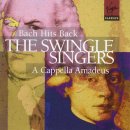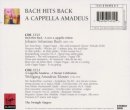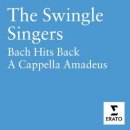|
|
Swingle Singers
Bach Hits Back
|
|
C-3 |
Bach hits Back, a new a cappella tribute [CD]
Bach Hits Back / A Cappella Amadeus [2-CD]
The Swingle Singers Anthology [4-CD] |







|
|
1. Chorale (Mvt. 8) from Cantata BWV 80, arranged for a capella choir by Ben Parry & Jonathan Rathbone [1:07]
2. Organ Fugue from Fantasia & Fugue [2:39]
3. WTC 1: Prelude No. 18 in G sharp minor, BWV 863 [2:59]
4. Chorale (Mvt. 7) from Cantata BWV 140, arranged for a capella choir by Ben Parry & Jonathan Rathbone [1:26]
5. Chorale for Tenor (Mvt. 4) from Cantata BWV 140, arranged for a capella choir by Ben Parry & Jonathan Rathbone [3:15]
6. Chorale Liebster Jesu, wir sind hier, BWV 373 [2:02]
7. Chorale Prelude In dulci jubilo (I), BWV 608 [1:57]
8. Chorale In Dulci dubilo, BWV 368 [1:12]
9. Andante from Sonata for solo violin No. 2 in A minor, BWV 1003 [3:36]
10. Allegro (Mvt. 1) from Brandenburg Concerto No. 3 in G major, BWV 1048 [2:43]
11. Aria for Soprano (Mvt. 9) from Cantata BWV 208, arranged for a capella choir by Ben Parry & Jonathan Rathbone [4:07]
12. Badinerie (Mvt. 7) from Orchestral Suite No. 2 in B minor, BWV 1067 [1:16]
13. WTC 2: Fugue No. 8 in E flat minor, BWV 877 [2:06]
14. Three-part Invention, BWV ___ [2:51]
15. Et resurrexit (Mvt. 18) from Mass in B minor BWV 232, arranged for a capella choir [2:40]
16. Aria for Soprano Bist du bei mir BWV 508 [2:50]
17. Aria for Soprano Blute nur (Mvt. 8) from Matthäus-Passion BWV 244, adapted to vocal ensemble [3:38]
18. Organ Fugue: Alla Gigue [2:03]
19. Air (Mvt. 2) from Orchestral Suite No. 3 in D major, BWV 1068 (Air on a G string) [4:21]
20. Little Organ Fugue [2:22]
21. Chorale Es ist genug (Mvt. 5) from Cantata BWV 60, arranged for a capella choir by Ben Parry & Jonathan Rathbone [1:55]
All arranged for a capella choir |
|
Ward Swingle |
|
Swingle Singers (a capella choir) |
|
Sopranos: Helen Massey, Deryn Edwards; Altos: Linda Stevens, Heather Cairncross; Tenors: Andrew Busher, Jonathan Rathbone; Basses: Ben Parry, David Porter-Thomas |
|
Virgin Classics VC-545049-2
Virgin Classics 7243-561472-2
=
Virgin Classics 9669562
= |
May 1991 |
CD / TT: 53:25
2-CD / TT: 106:30
MP3 / TT: 106:11
4-CD / TT: 218:03
MP3 / TT: 218:32 |
|
Recorded at the Sound Suite Recording Studios, London, Wngland.
Producers: Jonathan Rathbone, Ben Parry, John Milner with Steve Barnet; Balance Engineer: Pete Rackham.
See: Bach Hits Back - by Swingle Singers
Buy this album at:
CD (1995): Amazon.com | Amazon.co.uk | Amazon.de
2-CD (1998): Amazon.com | Amazon.co.uk | Amazon.de
Music Download 2-CD: Amazon.com | Amazon.co.uk | Amazon.de | iTunes
4-CD (2009): Amazon.com | Amazon.co.uk | Amazon.de
Music Download 4-CD: Amazon.com | Amazon.co.uk | Amazon.de | iTunes |
|
Swingle Redux
Steve Schwartz wrote (August 12, 2002):
Summary for the Busy Executive: Doo-bee plus doooo.
If you go to Amazon.com for listeners' comments, you'll find one that says, essentially, if you buy this CD, you have no taste. And that's all it does say. It offers no reason why the mere act of buying this CD bars you from the Temple of True Beauty. After all, those with taste already know why. Over the years, I've gotten the feeling that a lot of listeners, including some very fine musicians, think the Swingle Singers were mere Yannis or Teshes, that what they did was undeservedly easy. I've been a choral singer for a very long time, with repertoire that includes the likes of Schoenberg, Webern, Ligeti, Brahms, Mahler, and real Bach. I consider myself to have some appreciation of what it takes to pull off a choral performance. As far as I can tell, the Swingle Singers cleared two very high hurdles.
First, at least originally, their repertoire consisted exclusively of Bach instrumental works. Most of the time, one can't simply assign a voice to a part and just wail from the score. Aside from the obvious problem that instruments have a wider range than the human voice, one encounters the more subtle problems of how to assign a single line among various parts and how to achieve a pure instrumental effect vocally. Probably the most extreme example of Ward Swingle's ability to do this comes from his arrangement of C. P. E. Bach's largely unison keyboard "Solfeggietto," from the album Going Baroque - fifty-four seconds of riding the lightning - where hardly anybody gets more than a beat's worth of consecutive notes before an interruption from somebody else. The original Singers considered this the hardest thing they did. But all the arrangements required more than trivial skills. In aid of clarity and lightness, Swingle chose even his scat syllables carefully. Anyone who thinks these singers merely go "doo-bee doo" really aren't listening. I've sung many "Swingle-like" arrangements of Bach, and most of these many are goddamn awful - too thick, too silly, and about as close to the original as "Our Love" is to Romeo and Juliet. Ward Swingle's arrangements were little miracles of translation, where the new language gave you insights into the old, and they suited the voice besides.
Second, the singers themselves weren't just guys who happened to walk in off the street. Swingle recruited from the French conservatoires and from the cream of the Paris recording studios. Sometime, read the professional biography of Annie Germain, Claudine Meunier, or Jean-Claude Briodin. For a group of very fine musicians indeed, Swingle not only created arrangements, but discovered a choral sound that "worked" with the contrapuntal complexity of Bach - light and rhythmically flexible, with connections to such bop groups as Lambert, Hendricks, and Ross, Les Double Six, and the Gordons. He saw Bach as primarily a composer of music that danced, that razor-sharp rhythm and perfect intonation made up the road to success, because these things clarified Bach's intricate textures and moved the music along. He enhanced the singers' rhythm with a rhythm continuo of string bass and drum kit, never overdone.
The French group disbanded in 1973, and Swingle moved to England to found Swingle II, which itself has undergone a few transformations. He retired in the early Eighties, but he continues to advise and to occasionally arrange for the present bunch, once again known as the Swingle Singers. More than nationality has changed, however. A different approach prevails as to arrangement. Now, the singers generate all sounds vocally. The basses imitate the string bass, and some members, at least, have learned how to imitate the jazz drummer's brushes on cymbals, probably through a technique very close to spitting. That they almost always fool my ear amazes me. They yield nothing in blend or rhythm to previous incarnations of the group. For years, furthermore, they've managed to add vocal music and composers other than Bach to their repertoire, and again they do very well indeed. What they lack, however, is a star soloist who can emerge from the team bench, something they had at the outset in Christine Legrand. In thirty years, they've not managed to find another. The candidates on this CD are very good, but not magical.
Nevertheless, I found this a wonderful album. The Temple of Beauty rescinded my membership a long time ago. The arrangements are mostly new (the "Badinerie" from the second orchestral suite the only one I think I've heard before). The opening of the simple chorale "Ein' feste Burg" (BWV 80) just about raptures me out by the purity of its intonation. The several fugues for organ move mightily. Listen to the unearthly clarity of the chorale prelude on "In dulci jubilo" or of the andante from the second sonata for solo violin. These, to my mind, are great Bach performances, not simply great pop performances of Bach, and, what's more, the Swingle Singers in any of their incarnations came up with them as if such things were no big deal. Perhaps I'm too smitten to see the truth of the things, but I compare them to performers like Tureck and van Asperen.
The Singers haven't stood still. At least three controversial arrangements appear on the program: "Bist du bei mir," (BWV 508), a three-part invention, and the andante from the second solo violin sonata. For the latter two, the arranger has added parts, although parts in keeping with the implications of the harmony. For "Bist du bei mir," the arranger has added the equivalent of tail fins, with jazz harmonies, not completely bizarre, but certainly out of period. I happen to love it, and the original, after all, is nothing more than a bare-bones sketch in Anna Magdalena's notebook. Why not? The arrangement bears the same relationship to the original as Bach's chorale harmonizations do to their originals. And as far as "bizarre" goes, listen to the final cut: Bach's harmonization of the chorale "Es ist genug," appropriated by Berg for
the violin concerto.
I admit the album contains a couple of misfires, notably an arrangement of the chorale prelude on "Wachet auf," (BWV 140) which really does trivialize the original. I don't know who made the new arrangement (the Swingles for years have used arrangers other than their founder), but I much prefer Ward Swingle's original version from the Sixties. There's also an excerpt from the third Brandenburg which fails to take off. It seems thin. Perhaps this is a fault of performance, but it comes across as missing a necessary weight. Maybe you just can't do this with only eight singers.
Overall, however, a charming album. The sound has the usual miked and slight echo-chambery quality of most pop albums, but if you accept the genre, it shouldn't bother you.
Swingle Singers : Short History | Ward Swingle | Recordings | Bach Hits Back – Swingle Singers
|
|
|